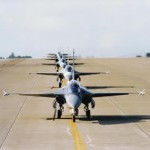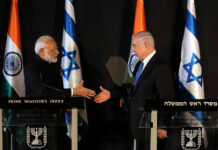
The unsettling appearance of a Chinese aircraft carrier has created quite a stir in the Pacific among those nations that rely heavily on the United States for warfighting protection and military hardware. With the Chinese carrier now underway on its second round of sea trials, the Pacific community is looking with increased urgency to improve air defenses. Taiwan and Japan in particular are in critical need of an upgrade to their existing air-superiority fighter forces.
Earlier this year, President Obama rejected Taiwan’s request to purchase as many as 66 new F-16 C/D aircraft to replace its aging fleet of F-16 A/B and F-5 fighters. The Obama administration has instead offered a deal to upgrade Taiwan’s existing fleet of the A/B versions of the F-16. This $5.85 billion upgrade will give the older F-16s most of the advanced capabilities of the C/D versions. With the upgrade, the older F-16s would receive enhanced radar, avionics, and weaponry. Taiwan was quick to publicly welcome the offer of the upgrade.
Unfortunately, the planned upgrade will do little to alleviate the problem of keeping the Taiwanese F-16 fleet in the air for any length of time. The F-16s and F-5s now in operation in Taiwan are tired aircraft that have already been in service far longer than their designed lifespan. The F-16s date back as far as 1992 and the F-5s are Vietnam-era aircraft that are of little use except as trainers. Taiwan has been plagued by a series of aircraft crashes and safety stand downs that are usually indicative of aging airframes that require continuous maintenance and can, over time, render the aircraft unsafe for normal operation.
Taiwan’s efforts to manufacture an air-superiority fighter of its own making yielded 130 aircraft that proved to be less capable than desired. With the assistance of American defense contractors, the initial concept was an idea that held a reasonable promise of delivering a homegrown fighter capable of meeting Taiwan’s air defense needs. Unfortunately, the project hit a snag when Taiwan was forced to exclude the high-thrust engines needed to make the aircraft a real warfighting threat. Enhanced models of the fighter are just now becoming a reality and may yet provide Taiwan with a viable homegrown air-superiority fighter.
Taiwan has also expressed a sincere interest in acquiring the new F-35 multirole fighter. There is very little likelihood that the F-35 will become part of the Taiwanese air fleet any time soon.
With the acquisition of new F-16s not likely in the short term and procurement of the F-35 little more than a dream, Taiwan’s ability to defend its air space against a determined Chinese aerial onslaught is critically limited, but the Taiwanese might have the capacity to give the Chinese a nasty reception in the event of open hostilities.
While Taiwan is forced to take whatever it can get to enhance its air defense capabilities, Japan remains undecided about the aircraft it wants as a replacement for its well-worn force of F-4EJ, F-2, and F-15J fighters. Recent accidents and groundings have exposed the Japanese air fleet’s maintenance nightmare of keeping its fighter aircraft aloft. Unlike Taiwan, Japan as a sovereign nation is not hogtied by the same political restrictions and second guessing facing Taiwan and is free to contract for the aircraft best suited to meet its air defense needs. That is, except for Lockheed Martin’s F-22 Raptor, an aircraft the United States is not yet willing to share.
Japan’s F-4EJ Kai Phantoms have been in service since the early 1970s and have certainly outlived their operational usefulness. The F-15Js have been operational since the early 1980s and are definitely showing their age. Production of the F-2 came to an end when the last aircraft was delivered on September 27 of this year. The air fleet is worn, outdated, and outclassed.
In 2010 both China and Russia intensified their testing of Japanese air defenses with hundreds of intrusions into Japanese air space – the largest number of unauthorized flights since 1991. The Japanese Air Self Defense Force (JASDF) was pushed to the limit in its efforts to meet this challenge in 2010 and the results were not cause for celebration. The intensity of the JASDF air operations further aggravated the problem of keeping aging aircraft operational.
With China recently unveiling its J-20 multipurpose fighter, reported to possess stealth technology and capability, and Russia announcing a joint project with India to develop its fifth-generation Sukhoi T-50 fighter, Japan is distressed to learn just how far behind potential adversaries its existing fighter defense force really is. The carrier sea trials being conducted by China have heightened the Japanese sense of being vulnerable to a host of very capable and very dangerous enemies.

Unlike Taiwan, Japan is in the enviable position of being free to choose a replacement fighter that can stand up to the Chinese challenge. Japan has narrowed the candidates she considers best able to defend her air space to three aircraft, the Boeing F/A-18E/F Super Hornet, Lockheed Martin’s F-35 Joint Strike Fighter (JSF), and BAE System’s Eurofighter Typhoon.
One key criterion the Japanese government is using to determine the replacement to be chosen is the degree of manufacture/assembly the parent company will allow to be performed in Japan. All three manufacturers have indicated a willingness to offer Japan a licensing agreement giving Japan a specified level of manufacturing/assembly authority, but each is offering a slightly different level of authority.
The Japanese government has not made any announcement designating the aircraft to be purchased, but an announcement is expected late this month or early next month.
Most observers believe that the F-35 Lightning II is the replacement most likely to be selected as it is the most technologically advanced of the three and the most capable. Japan has historically opted for the most sophisticated weaponry available. However, the F-35 has experienced numerous production and testing delays and it carries a very hefty price tag. The F/A-18E/F Super Hornet is a very capable aircraft with an exceptional performance record and a much more palatable price tag. The Eurofighter Typhoon is also capable, but Japan has never bought a European warplane before and the United States must certainly be pressuring Japan to stay with an American aircraft. Some observers have also raised doubts about the Typhoons ability to be fully integrated into a largely American-equipped force. They are concerned that the Typhoon would unnecessarily complicate a maintenance and supply chain that is, by its very nature, already complicated enough.
While the F-35 appears to be the best fighter for the job, cost is a major consideration as well. Japan is burdened with debt that exceeds 200 percent of GDP and is continuing to increase. Japan’s leaders will have to decide between getting the best at great cost or getting a solid performer for a much lower cost. Which is now more important for Japan, the very best fighter available or a good first-class fighter that won’t break the piggybank?
About the author: Richard D. Dudley
U.S. Marine Corps Maj. (Ret) Richard D. Dudley has been serving with the Marine Corps in active duty for 26 years, rising from Private (E1) to retire as a Major (O4) with experience in numerous shipboard and shore-based deployments. During his service Maj. Dudley has specialized in logistics and support. For the past 15 years he is living in Japan serving as an independent sales consultant/local area manager with the Marine Corps Air Station in Japan.












